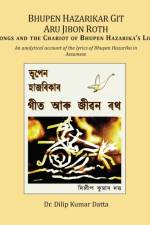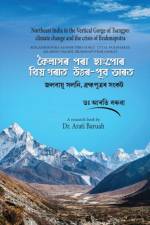- An analytical account of the lyrics of Bhupen Hazarika in Assamese
av Dilip K Datta
681
This seventh and final edition of Bhupen Hazarikar Git Aru Jibon Roth came about after the author, late Dr. Dilip Kumar Dutta (January 2, 1939 - September 26, 2019), revised and/or added, some 250 new pages to the previous out-of-print 6th edition. He wrote them over a few years following my father Dr. Bhupen Hazarika's death on November 5th, 2011 in Mumbai. His body was brought home to Guwahati for what was to become his historic public cremation in Jalukbari on November 9th, 2011, when several hundred thousand people from all walks of life and ages attended all day while people all over Assam, inside her Northeastern sister states and as in West Bengal and Bangladesh, mourned his loss publicly. While alive he was already an iconic legend and everywhere young and old joined singing contests to sing his songs. That day, also present, was a forest of journalists and cameramen who recorded the extraordinary event whose archives will reveal for posterity one of the reasons why people keep installing Bhupen Hazarika's statues all over Assam. The Government of Assam spared nothing in affording Bhupenda and his family the highest state funeral, making this spontaneous mass outpouring of grief India's head-lining news for days and weeks to come. As a greatly loved personality and singer whose hundreds of songs were the background music to so many people's personal lives, his loss may have somehow struck them as a loss of their own voice. What transpired after the cremation was an intense period of reflection among thinking Indians and politicians as to the possible socio-political significance of such an extraordinary phenomena in the face of India's and the central government's perception about and relationship with the Northeastern region. While the central government hastened to posthumously award my father the Padma Vibhushan (2012) and then the Bharat Ratna ( 2019 ), India's highest civilian award, many had wondered before and still do now why it did not happen earlier when he was alive. Questions and legal matters surfaced regarding his will, still in the courts to this day, even as nationally, his popularity has kept growing to almost become a household name in India. In response to this phenomena and in order to bring some missing facts about my father to the public, Dr. Dutta started to update Bhupen Hazarikar Git Aru Jibon Roth by addressing some of those issues including my father's important relationships with his family members, business partners and the difficulties he faced before and after the onset of Alzheimer's disease which ultimately silenced him. As yet, still remains enigmatic the question why the grieving among his Northeastern fans ran so deep and long. Dilip Dutta split his time between Kingston, Rhode Island, as math professor and during the summer months he travelled to Jorhat, Assam, to spend his time writing passionately about Assam, its people and its history. He had befriended my father in the 1970s and often visited him at his Tollygunge residence in 'Calcutta'. Every time my father travelled to the USA, he spent time with Dilip Dutta in Rhode Island, where he lived with his wife Ranima. Far from the hectic life of a performing artist in India (earlier) and later as 'culture czar' with the Sahitya Akademi, a prestigious and high profile five year appointment that straddled the demanding worlds of show-business and politics when deep down, every one who knew him would agree, his heart really belonged to the simplest people of India. My father greatly enjoyed the time spent in relaxed anonymity with his friend and biographer at his seaside home.




